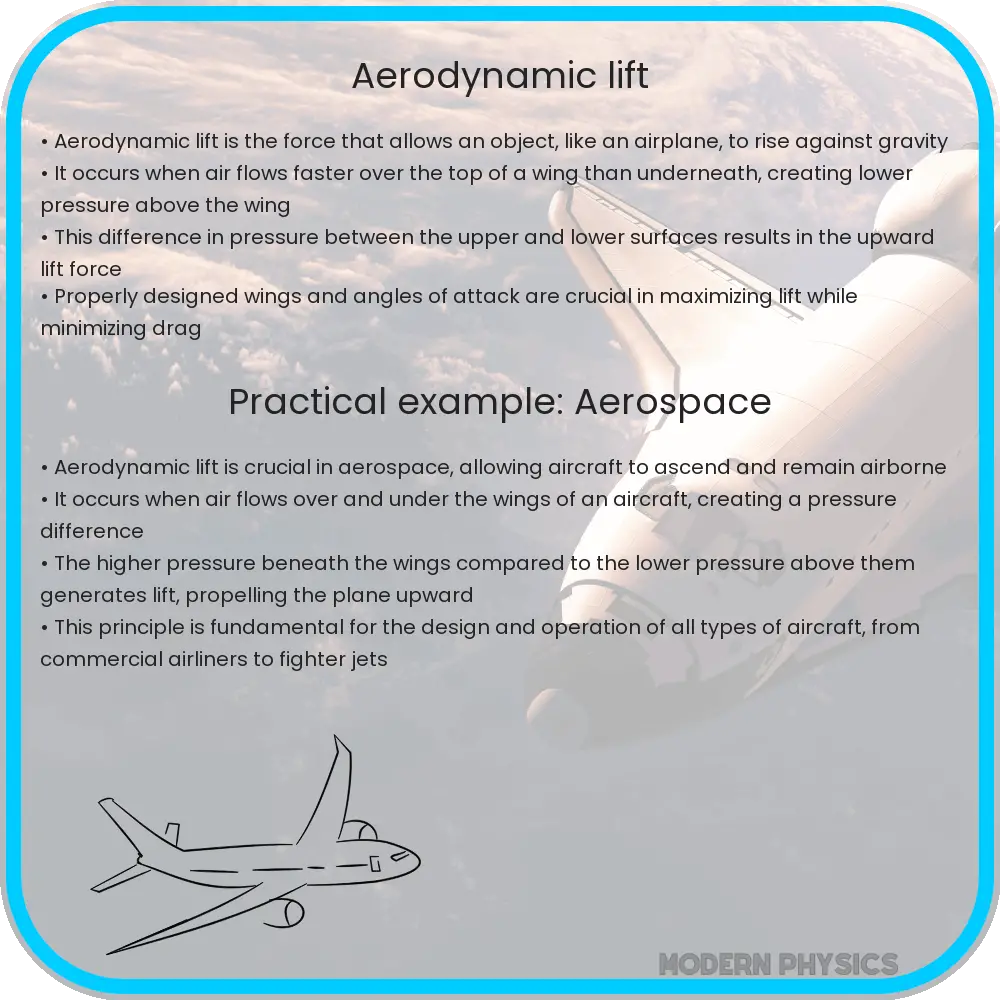Explore the principles of aerodynamic lift, its applications in aviation and sports, and future advancements in eco-friendly air travel.

Understanding Aerodynamic Lift: Fundamentals and Applications
Aerodynamic lift is a crucial principle in fluid dynamics, primarily applied in the design and operation of aircraft. This force is responsible for making an object move through the air. Understanding the principles of aerodynamic lift not only helps in the design of efficient aircraft but also in numerous other applications in engineering and science.
Principles of Aerodynamic Lift
At the heart of aerodynamic lift lies Bernoulli’s principle, which states that an increase in the speed of a fluid occurs simultaneously with a decrease in pressure. In the context of an aircraft wing, air moving faster over the top surface creates a lower pressure compared to the slower-moving air under the wing. This pressure difference results in an upward lift force.
Another critical concept is the Coanda effect, where a jet flow attaches itself to a nearby surface and follows its contour. In aerodynamics, this effect helps in explaining how airflow attaches to the curved surface of a wing, contributing to lift.
Applications of Aerodynamic Lift
Aerodynamic lift finds its most prominent application in aviation. Aircraft wings are designed to maximize lift while minimizing drag, allowing planes to take off, maintain altitude, and land efficiently. The shape, size, and angle of the wings are critical in determining the amount of lift generated.
Beyond aviation, aerodynamic lift principles are also applied in sports. For example, golf balls are designed with dimples that reduce drag and increase lift, allowing them to travel farther. Similarly, race cars employ aerodynamic designs to generate downforce (negative lift) to improve traction and handling at high speeds.
Theoretical Framework
The theoretical framework of aerodynamic lift is grounded in fluid mechanics and Newton’s laws of motion. Newton’s third law, which states that for every action, there is an equal and opposite reaction, is particularly relevant. As the wing pushes air downwards, the air pushes the wing upwards, generating lift.
The lift coefficient, \( C_L \), is a dimensionless number that quantifies lift. It is calculated using the formula:
\[ C_L = \frac{L}{\frac{1}{2} \rho v^2 A} \]
where \( L \) is the lift force, \( \rho \) is the air density, \( v \) is the velocity of the aircraft, and \( A \) is the wing area.
Advanced Aspects of Aerodynamic Lift
Exploring beyond basic principles, the study of aerodynamic lift delves into complex phenomena such as boundary layer dynamics and vortex generation. The boundary layer, a thin layer of air lying close to the surface of the wing, plays a pivotal role in lift generation and drag. Managing the boundary layer through design and technology, like winglets or turbulators, can significantly enhance aircraft performance.
Vortex generation, another advanced concept, involves the creation of circular patterns of rotating air left behind by the wing. While these vortices can be a source of drag, they also contribute to the lift. Understanding and controlling these vortices is crucial, especially in high-performance aircraft and in avoiding wake turbulence.
Challenges and Future Directions
The field of aerodynamics is constantly evolving, with ongoing challenges like reducing the environmental impact of flight, improving fuel efficiency, and enhancing safety. Advancements in materials science, computational fluid dynamics, and aerodynamic modeling are paving the way for more efficient and eco-friendly aircraft designs.
Emerging technologies such as blended wing bodies, adaptive wing designs, and electric propulsion systems are set to revolutionize the principles of lift in aviation. These innovations promise not only to improve the aerodynamic efficiency but also to reduce the carbon footprint of air travel.
Conclusion
Aerodynamic lift is a foundational principle in fluid dynamics with widespread applications from aviation to sports. Rooted in the fundamentals of Bernoulli’s principle and Newton’s laws, the concept of lift transcends into complex phenomena like boundary layer dynamics and vortex generation. As technology advances, the understanding and application of aerodynamic lift continue to evolve, driving innovations in various fields. The future of aerodynamics holds exciting prospects, with potential breakthroughs in eco-friendly and efficient air travel, highlighting the ever-evolving nature of this dynamic field.
Whether in the design of faster, more efficient aircraft or in enhancing the performance of sports equipment, the principles of aerodynamic lift play a pivotal role. Its continuous study and application are crucial in pushing the boundaries of what’s possible in technology and engineering, making it a fascinating and vital area of scientific inquiry.
